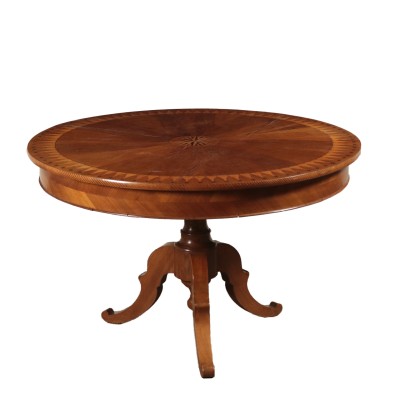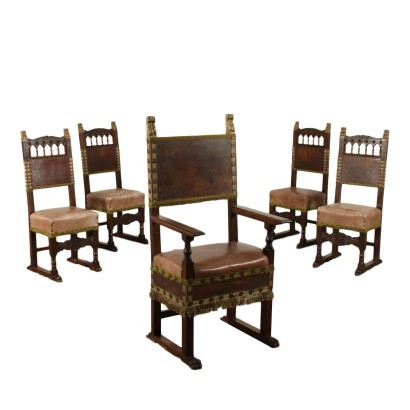Round Table, Ebony Marple and Walnut Italy 19th Century
Features
Age: 19th Century / 1801 - 1900
Origin: Italy
Main essence: Maple , Ebony , Walnut
Description
Table supported by turned baluster thet ends with wavy feet. Round countertop made with an halo of inlaid marple and ebony slabs. Threaded edge.
Product Condition:
The item shows signs of wear due to age. Any damage or loss is displayed as completely as possible in the pictures. It may require restoration and recovery of french polish.
Dimensions (cm):
Height: 77
Diameter: 122,5
Additional Information
Age: 19th Century / 1801 - 1900
19th Century / 1801 - 1900Main essence:
Maple
Hard, light wood used for inlays. It grows mainly in Austria, but it is widespread throughout the northern hemisphere, from Japan to North America, passing through China and Europe. It is one of the lightest woods ever, tending to white, it is similar to lime or birch wood. The briar is used in the production of ancient secretaires .Ebony
Without any doubt it is one of the most precious and appreciated essences ever. Very hard and resistant, it is pleasant to the touch thanks to its smoothness, it is a wood with a typical black color. Being very rare it was traded as a precious metal and frequently forged. Because of its hardness, it is very difficult to work, which is why the term cabinetmaker, which indicates the very skilled craftsman in fine carpentry works, derives from this very essence. In modern times, it was introduced by the Flemings and Germans and immediately enjoyed success with the French. The golden period for Ebony was the Baroque, especially in the Boulle style workings. In general it is widely used in inlays, but also for furniture upholstery, for contrasting effects alongside brass, bronze and tortoiseshell.Walnut
Walnut wood comes from the plant whose botanical name is juglans regia , probably originally from the East but very common in Europe. Light or dark brown in color, it is a hard wood with a beautiful grain, widely used in antique furniture. It was the main essence in Italy throughout the Renaissance and later had a good diffusion in Europe, especially in England, until the advent of mahogany. It was used for solid wood furniture and sometimes carvings and inlays, its only big limitation is that it suffers a lot from woodworm. In France it was widely used more than anything else in the provinces. In the second half of the eighteenth century its use decreased significantly because mahogany and other exotic woods were preferred. It could also interest you


























